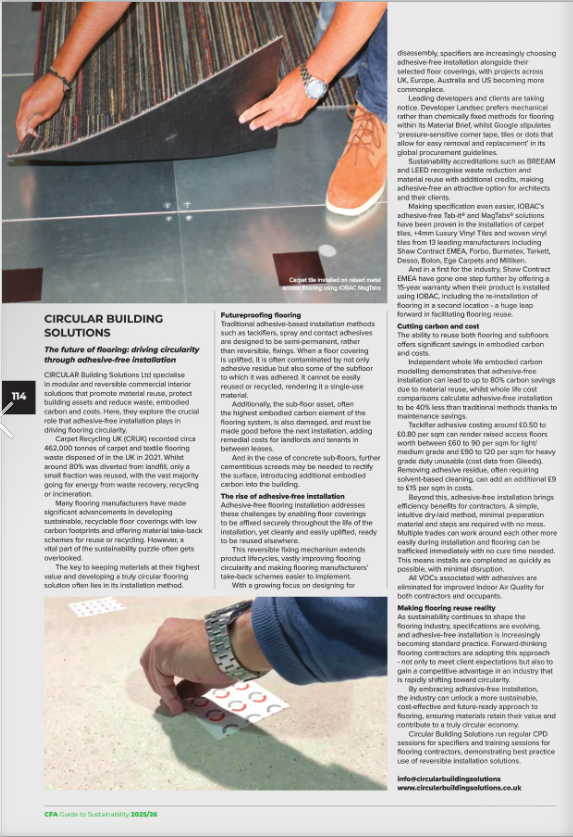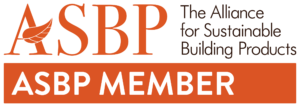The 2025-2026 Guide to Sustainability from the CFA (Contract Flooring Association) featured the following article from us on how reversible adhesive-free flooring installation can drive material circularity.
This annual publication highlights key information, products, services and case studies, and aims to help anyone with a current flooring project (with sustainability at its heart) to deliver best practice.
At the same time, it provides some thought leadership pieces around the future of sustainability in the commercial flooring sector.
A Modern Method of Installation
The UK Sustainable Flooring Alliance (formerly Carpet Recycling UK – CRUK) recorded circa 462,000 tonnes of carpet and textile flooring waste disposed of in the UK in 2021. Whilst around 80% was diverted from landfill, only a small fraction was reused, with the vast majority going for energy from waste recovery, recycling or incineration.
Many flooring manufacturers have made significant advancements in developing sustainable, recyclable floor coverings with low carbon footprints and offering material take-back schemes for reuse or recycling. However, a vital part of the sustainability puzzle often gets overlooked.
The key to keeping materials at their highest value and developing a truly circular flooring solution often lies in its installation method.
Futureproofing Flooring
Traditional adhesive-based installation methods such as tackifiers, spray and contact adhesives are designed to be semi-permanent, rather than reversible, fixings.
When a floor covering is uplifted, it is often contaminated by not only adhesive residue but also some of the subfloor to which it was adhered. It cannot be easily reused or recycled, rendering it a single-use material.
Additionally, the sub-floor asset, often the highest embodied carbon element of the flooring system, is also damaged, and must be made good before the next installation, adding remedial costs for landlords and tenants in between leases.
And in the case of concrete sub-floors, further cementitious screeds may be needed to rectify the surface, introducing additional embodied carbon into the building.

The Rise of Adhesive-free Installation
Adhesive-free flooring installation addresses these challenges by enabling floor coverings to be affixed securely throughout the life of the installation, yet cleanly and easily uplifted, ready to be reused elsewhere.
This reversible fixing mechanism extends product lifecycles, vastly improving flooring circularity and making flooring manufacturers’ take-back schemes easier to implement.
With a growing focus on designing for disassembly, specifiers are increasingly choosing adhesive-free installation alongside their selected floor coverings, with projects across UK, Europe, Australia and US becoming more commonplace.
Leading developers and clients are taking notice. Developer Landsec prefers mechanical rather than chemically fixed methods for flooring within its Material Brief, whilst Google stipulates “pressure-sensitive corner tape, tiles or dots that allow for easy removal and replacement” in its global procurement guidelines.
Sustainability accreditations such as BREEAM and LEED recognise waste reduction and material reuse with additional credits, making adhesive-free an attractive option for architects and their clients.

Making specification even easier, IOBAC’s adhesive-free Tab-it® and MagTabs® solutions have been proven in the installation of carpet tiles, +4mm Luxury Vinyl Tiles and woven vinyl tiles from 13 leading manufacturers including Shaw Contract EMEA, Forbo, Burmatex, Tarkett, Desso, Bolon, Ege Carpets and Milliken.
And in a first for the industry, Shaw Contract EMEA have gone one step further by offering a 15-year warranty when their product is installed using IOBAC, including the re-installation of flooring in a second location – a huge leap forward in facilitating flooring reuse.
Cutting Carbon and Cost
The ability to reuse both flooring and subfloors offers significant savings in embodied carbon and costs.
Independent whole life embodied carbon modelling demonstrates that adhesive-free installation can lead to up to 80% carbon savings due to material reuse, whilst whole life cost comparisons calculate adhesive-free installation to be 40% less than traditional methods thanks to maintenance savings.
Tackifier adhesive costing around £0.50 to £0.80 per sqm can render raised access floors worth between £60 to 90 per sqm for light/medium grade and £90 to 120 per sqm for heavy grade duty unusable (cost data from Gleeds). Removing adhesive residue, often requiring solvent-based cleaning, can add an additional £9 to 15 per sqm in costs.
Beyond this, adhesive-free installation brings efficiency benefits for contractors. A simple, intuitive dry-laid method, minimal preparation material and steps are required with no mess. Multiple trades can work around each other more easily during installation and flooring can be trafficked immediately with no cure time needed. This means installs are completed as quickly as possible, with minimal disruption.
All VOCs associated with adhesives are eliminated for improved Indoor Air Quality for both contractors and occupants.
Making Flooring Reuse Reality
As sustainability continues to shape the flooring industry, specifications are evolving, and adhesive-free installation is increasingly becoming standard practice. Forward-thinking flooring contractors are adopting this approach – not only to meet client expectations but also to gain a competitive advantage in an industry that is rapidly shifting toward circularity.
By embracing adhesive-free installation, the industry can unlock a more sustainable, cost-effective and future-ready approach to flooring, ensuring materials retain their value and contribute to a truly circular economy.





Comments are closed